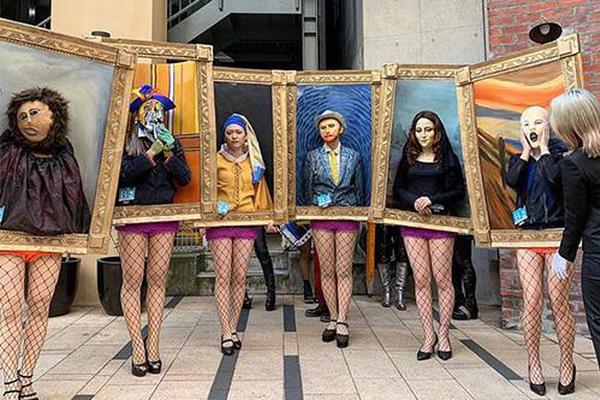【】
Snap Inc. has bet its future on being the anti-Facebook.
On Wednesday, the company made its biggest move yet—a major redesign to its flagship app—to show just how different it is from the social network.
But the redesign simultaneously takes a major page from Facebook's playbook—relying on algorithms to personalize what you see.
The redesign, rolled out slowly to users over the coming weeks, separates the app into two feeds and infuses each of them with algorithms. Snapchat is now embracing the black-box equations that it once shunned.

The move comes as Snapchat is struggling as a public company with nonexistent user growth and a disappointing ad business.
The two feeds are starkly different. One feed ranks friends primarily based on how often the user interacts with them. The other suggests community and publisher content primarily based on users' interests—previous actions on Snapchat.
CARD ID: 297175
Visually, Snapchat doesn't look that different in part because the biggest change was removing something. Prior to the redesign, Snapchat was divided by Chat (left), Stories (right), and Discover (far right). Snapchat no longer has the Stories feed, which had included content from friends, publishers, and the community. Now, Snapchat has Friends (Chat plus Stories from friends) and Discover (Stories from publishers and community).
CARD ID: 297244
The Friends feed will list most recent chats followed by a user's best friends as determined by Snapchat's algorithm. The Discover feed will rank publishers, with subscriptions as a high-priority signal followed by frequency of consumption, time-spent consuming, and other behaviors.
But behind the feed, Snapchat is a lot different. Having feeds based on usage and interests is a major shift from Snapchat's last six years of ordering snaps chronologically. The hope is that the app shows users more of what they want with as little friction as possible.
That personalization and ease of use is an ethos similar to Facebook and its News Feed, where users can endlessly scroll. So despite pushing back against comparisons to Facebook, Snap's latest bet is similar to Mark Zuckerberg's mighty algorithm that surfaces what its 2 billion monthly active users want to see.
An algorithm isn't the only big change to come. Snapchat also reversed its course on influencers and said they'll be introducing better distribution and monetization options in 2018. It also brought back a previously shutdown feature called auto-advance where Stories automatically play after one another.
Why all the big changes? The app needs to be better to use for its loyal users and for newcomers. As much as Snapchat tries to be anti-Facebook, they still compete on everything essentially—they fight for attention from users, publishers, and advertisers. So far, investors haven't been favorable to Snap while Facebook's stock continues to soar.
And yet, Snap's main talking point for the redesign is a dig at Facebook, shared by CEO Evan Spiegel in an opinion piece published Wednesday and in a 60-second video. Snapchat sees flaws in "social media" apps and is attempting to fix it by separating the two words within its product. Snapchat offers "social" and "media," Spiegel said. Now, it has two feeds that embody those words.
"One of the complaints we’ve heard about social media is that photos and videos from your friends are mixed in with content from publishers and creators and influencers. But your friends aren’t content. They’re relationships," Spiegel said in a video explainer of the redesign.
Spiegel's right in that individuals get confused in how and why content is shared within Facebook's News Feed. A recent example came via questioning by U.S. lawmakers earlier this month when Facebook testified in court, along Google and Twitter, on Russian trolls manipulating users via News Feed during the 2016 election. It's no secret that Facebook has a major fake news problem, and now even Facebook investor Sean Parker has questioned the negative effects it's had on humans.
The concept of two feeds is one way Facebook is considering in an attempt to demystify and improve its experience. In tests within six markets, Facebook removed posts from Pages (a.k.a. publishers, like those in Snapchat Discover) in the original News Feed and put them in another feed. Therefore, the original News Feed would be only content from friends.
But Snapchat isn't like Facebook when it comes to content, and it won't be exactly copying its algorithms.
"The Snapchat solution is to rely on algorithms based on yourinterests — not on the interests of 'friends' — and to make sure media companies also profit off the content they produce for our Discover platform," Spiegel wrote in an op-ed.
Unlike Facebook, Snapchat also remains committed to editorial judgment on content. All Stories shown in Discover are editorially-curated or moderated. Even though Stories in Discover will be ranked by an algorithm, Snapchat has a programming team that can choose to promote a Story, such as a breaking news event, to users.
Even if Facebook pushed out its own two feeds, the content from friends and from publishers isn't exactly the same on the two apps. Snapchat is primarily vertical, full-screen photo and videos. For now, vertical content is only one, seldom-used feature within Facebook.
As Spiegel said in the video, a big difference between Facebook and Snap is Snapchat's focus on relationships. Zuckerberg preaches community, as in bringing people together around certain interests. Spiegel positions Snapchat as an app for an individual and their network of friends regardless of mutual interests.
Snapchat provides a portal to conversations with friends and then to content that can be enjoyed alone. It needs people — users, advertisers, publishers, investors — to believe that. Now, Snap has a product to embody that ethos rather than just talking about it.
CARD ID: 297176
TopicsFacebookSnapchatSocial Media
- 头条新闻
- Give your kitchen sponge a rest on this adorable bed
- Woman rebuffs body shamers who turned her crop top Instagram into a meme
- The solar eclipse shows up beautifully in weather forecast models
- The solar eclipse shows up beautifully in weather forecast models
- Two astronauts just installed a new parking spot on the International Space Station
- Hillary Clinton calls Donald Trump 'a creep' in election memoir
- Incredible moment reporter helps rescue man caught in Harvey floods, live on TV
- The most burning 'Game of Thrones' question: Where the eff is Gendry?
- MashReads Podcast: What makes a good summer read?
- 'Game of Thrones' One Daenerys convo will be her downfall
- 图片新闻
- 新闻排行榜








